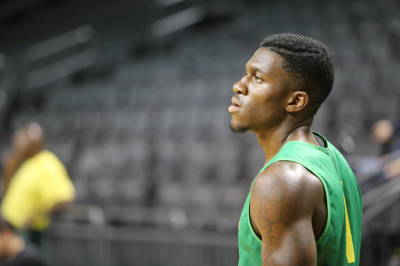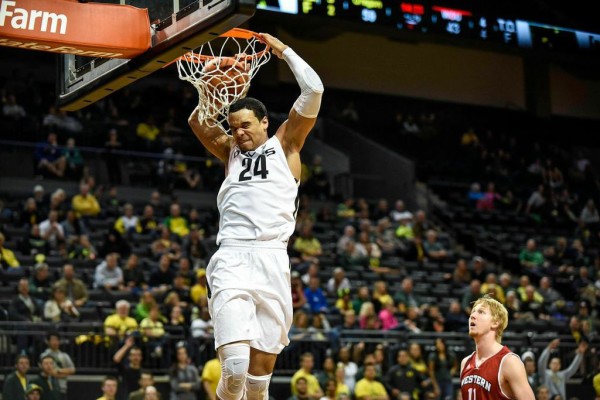Repercussions of Dylan Ennis’ Short-Lived Career at Oregon
Posted by Andrew Murawa on January 7th, 2016Wednesday was a day of mixed emotions around the Oregon basketball program. Early in the day it was announced that graduate senior point guard Dylan Ennis would miss the rest of the season with the same foot injury that had kept him out of the Ducks’ first 12 games of the season. This announcement effectively ends Ennis’ career in Eugene before it ever began, relegating him to a role as a cheerleader and mentor on the bench for the remainder of his time there. The good news is that the Ducks bounced back from a loss to Oregon State in its Pac-12 opener to score a solid home win over a California team that is beginning to look very much like the team we expected. While the injury to Ennis is a downright bummer, can the Ducks still be considered among the Pac-12 favorites despite his absence?

A Foot Injury Ended Dylan Ennis’ Oregon Career Before It Ever Really Got Started. (Oregon Athletics)
First, on Ennis. After starting his career as a promising if erratic point guard at Rice, he made the jump to the big leagues in two tremendously effective years at Villanova (averaging 9.9 points and 3.5 assists per game in a 33-win junior year, sharing point guard duties with Ryan Arcidiacono). At 6’2”, he knew that his best chance to maximize his professional potential lay in playing the point full-time. And with a potential logjam looming in the Villanova backcourt, the notion of sharing minutes again with Arcidiacono as well as freshman Jalen Brunson pushed Ennis to make the jump to Dana Altman’s transfer-friendly program. From there, it was a simple twist of fate that led to a foot injury in preseason practice. Altman tried to play him in late December in 10 largely ineffective minutes against Western Oregon; and he got 11 more minutes of action against Oregon State where he was clearly not comfortable with weight on his bad foot. With a redshirt year already lost to his first transfer, Ennis’ collegiate eligibility is likely finished barring a Hail Mary on a sixth-year.
In Ennis’ stead this season, sophomore Casey Benson has been the Ducks’ primary point guard. And he’s been good. He runs the offense; he never turns the ball over; he’s a decent defender. What he is not, however, is any sort of scoring threat (5.1 PPG in 26.4 MPG). On a team chock full of primary and secondary scoring threats, though, that may not be the worst thing in the world. If Benson can get the ball upcourt, move the Ducks into their sets, and then prove himself capable of knocking in maybe a third of his three-point attempts, that could be plenty good. Sophomore Dillon Brooks, while not the most conventional offensive threat around, has been the Ducks’ primary scorer – and a darn good one at that. He can hit from deep (although he’s a better shooter than the 25 percent he’s made from beyond the arc this year); he’s got a crafty mid-range game (48.4 percent on two-point jumpers and 62.3 percent on shots at the rim); he’s an underrated distributor (assisting on almost a quarter of teammates’ made field goals in the Ducks’ two Pac-12 games); and he’s a capable offensive rebounder.
And then there’s freshman Tyler Dorsey. He got off to a blistering start this year, knocking in 13 of his first 28 threes before suffering a gruesome-looking but harmless knee injury against UNLV. The combination of that injury, which kept him out of action for the two following games, and his success from behind the arc, may have limited his overall effectiveness. While he is certainly a terrific three-point shooter, his upside more accurately lies in an ability to mix that outside shot in with a smart mid-range game off the bounce. At this point, he’s taking more than 50 percent of his field goal attempts from three-point range. As long as he’s making 47.3 percent of them, bombs away! But as the season goes on, Dorsey is going to need to become a more balanced offensive threat.
The best part of Oregon’s roster is that there are a host of other players who are very effective offensive contributors without having plays run for them. Chris Boucher can score off putbacks and in transition. Or he can stand in the corner and knock down threes. Or he can take a pass in the mid-range and put the ball on the floor and get to the rim. Elgin Cook can do many of the same things and hasn’t even played his best basketball yet. Dwayne Benjamin is excellent in transition and can effectively spot up at the three-point line. And then there’s sophomore center Jordan Bell, just back from a foot injury of his own, who appears to own a more polished set of offensive skills around the hoop this season. Each of these guys has the potential to be great “role” players (role in quotations, because calling a guy like Boucher a “role player” seems like a criticism), but in order for the Ducks to truly live up to its potential when Ennis was an eventuality rather than a missed opportunity, Dorsey and Brooks will need to be the new catalysts.
There is reason for hope that such a possibility may come to pass, but as of right now, the “left to prove” side of the scale weighs far heavier than the “foregone conclusion” side. This Oregon team will certainly get better through conference play as Altman teams always do, but without Ennis in the lineup, its upside doesn’t match that of California, Utah and once-again conference-favorite Arizona. Even teams like Oregon State and USC could be considered a little more proven.











































